[Trade Journal]
Publication: Western Electrician
Chicago, IL, United States
vol. 36, no. 23, p. 458-459, col. 2-3,1-2
Long-Distance High-Tension
Transmission in California.†
BY JOHN A. BRITTON.
In the year 1888 attention in the engineering world was attracted by the Folsom Water Power Company determining to build a dam across the American River, near the town of Folsom, and to erect a power house some 2 1/2 miles south of the dam on the river, conveying water by a canal having a capacity of 40,000 miners' inches, to low-head turbine wheels, under a head of 65 feet. Four 750-kilowatt units were installed, generating current at 800 volts, stepping up to 10,000 volts, and conveying the current thus generated to the city of Sacramento, 22 miles distant. The promoters of this enterprise were discouraged by the inability at that time of engineers to guarantee that 10,000 volts could be safely carried that distance for commercial purposes. In 1895 this dream became a reality and Sacramento city was supplied with current generated at Folsom. While the insulation provided gave more or less trouble initially, this was gradually overcome. In 1892 the late A. W. Decker, electrical engineer, acting for the San Antonio Light and Power Company at Pomona, Cal., recommended the installation of electric equipment at the power plant of that company to convey by means of step-up transformers a pressure of 10,000 volts over approximately 16 miles of line to the city of Pomona. The generators as finally installed delivered single-phase current at a pressure of 500 volts and the transformers were wound in the ratio of 1 to 2. There were 10 transformers in service on the primary, giving 10,000 volts, with a capacity of six kilowatts each, installed. Glass insulators were used upon this line.
 |
| Fig. 1. Latest Type of Four-Part Insulator. |
In 1895 there was begun the construction of a waterpower plant near Nevada City, in Nevada County, in the state of California, to transmit about 1,000 horsepower a distance of five miles, with generators wound direct for 5,000 volts. The water was conveyed from a dam on the South Yuba River through 3 1/2 miles of flume, having a capacity of 8,500 cubic feet per minute, and delivered to a 42-inch oipe, 286 feet long, with a head of 190 feet. There were installed at that time two 330-kilowatt units.
From these small beginnings has grown a system throughout the state aggregating in generator capacity at present installed over 50,000 kilowatts and units of 5,000 kilowatts with varying heads up to 1,530 feet. In the central part of the state, utilizing the waters of the western slope of the Sierra Nevada Mountains, there are at the present time in continuous operation 577 miles of ditches, 25.5 miles of flumes, operating 14 waterpower plants, having installed 41 generators, with a rated capacity of 50,790 kilowatts, and having a water storage in numerous lakes aggregating over 3,000,000,000 cubic feet, or 1,500,000 miners' inches, for 24 hours. From these power houses there are in continuous service 715 miles of pole line and 734 miles of circuit operated at 50,000 to 60,000 volts, and 479 miles of circuit at voltages varying from 10,000 to 50,000, and 90 miles at lesser voltages, not including any local distribution. Power is delivered to 94 sub-stations, with 75,000 kilowatts in transformer capacity installed scattered over 21 counties and 33 cities in the state, representing a population of over 60 per cent. of the entire state of California and covering an area of 15,000 square miles. This power is regularly transmitted 232 miles, and by reason of certain conditions at times existing at the different power plants necessitating the transmission over all lines from one power plant, has been successfully operated 325 miles at 55,000 volts.
The first transmission line to reach the Bay shore was that of the Bay Counties Power Company, carrying current generated at Colgate on the Yuba River, about 28 miles northeast of the city of Marysville. This line was started at 44,000 volts, which voltage has since been raised to 55,000. The construction of the line was of round cedar poles, from the state of Oregon, an average height of 50 feet, and the character of construction substantially that now in use, but with a less separation in some instances than was subsequently found necessary. The greatest difficulty encountered in the carrying of the high potential was in and about the bays mentioned, due to the heavy salt fogs that for certain periods of the year hang densely over the land, sometimes lasting for days. In these particular districts the insulation has broken down at most unexpected places, causing the burning off of poles and shortening the line. The new four-part insulator, Fig. 1, with iron pins, has entirely overcome this defect and for the last season under the most trying circumstances no trouble has occurred, the number of hours of shutdowns upon all of these lines being of a negligible quantity.
One of the greatest engineering feats ever accomplished and one that has never received from the engineering world the attention which it deserves, was the construction in 1901 of the famous Carquinez span of four steel cables, suspended from steel towers. This span crosses the Carquinez Straits, connecting San Pablo and Suisun bays, and is 4,427 feet in length between towers, having at its maximum point of dip an elevation of 206 feet above high-water line. The maximum sag of the wire between the two steel towers on the north and south sides of the straits is, 257 feet. The main tower, in Solano County, on the north side of the straits, is 224 feet in height, and the bluff at the point of construction is 162 feet above tide-water; on the south side the tower is 64 feet in height and the bluff 400 feet above tidewater.
Experience has demonstrated that the form of lightning arrester which gives good service at low voltage is absolutely useless on high-tension lines. While these were first installed, they have since in every case been abandoned. At the present time nothing is used but the Horn gap arrester. As the voltage of the lines has been raised and the insulation increased the damage due to lightning is steadily decreasing. It is well to state that beyond the line of the foothills of the Sierra Nevada Mountains lightning rarely occurs; possibly once a year throughout the Sacramento and San Joaquin valleys and along the bay shore are there any discharges of lightning that would be detrimental to the lines.
The first construction of lines in this state was 40 to 50 poles to the mile, insulators being used at a maximum cost of 15 cents. All new lines are now being constructed on the basis of 20 poles to the mile, and the four-part insulators illustrated are being used, costing approximately $2 each, and weighing about 30 pounds.
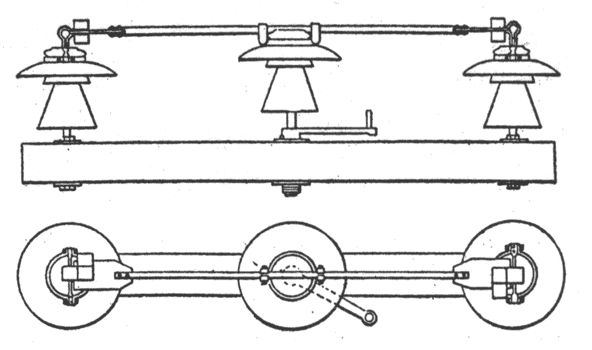 |
| Fig. 2. Form of Out-Door Switch for High Tension. |
Much work has been done in designing and carrying out the construction of outdoor switches, as shown in Fig. 2. Experiments have been continuous along the lines of oil switches, and experience has demonstrated sufficiently that this switch as at present constructed is entirely satisfactory and will handle heavy currents under high pressures. Double-break and quadruple-break oil switches are now being made, the latter being used for very heavy service in the large power houses. Fig. 3 shows one form of oil switch, and also shows the method of constructing fireproof switch galleries, the construction of which, so far as the writer is advised, is entirely original with the Pacific Coast. The switching is done by opening the three legs at the same time, the single-pole arrangement having been found to be extremely unsatisfactory for obvious reasons. Fig. 4 illustrates the present arrangement not only of the fireproof switch galleries but of modern construction of a power house, showing location of waterwheel, generator, exciter and switchboard.
As evidencing the care exercised in protecting low-tension circuits from high-pressure wires where the low-tension parallels the high-tension, in the event that there should be any fall to the ground of the insulation of the high-tension, Fig. 5 is fully illustrative.
The difficulties attendant upon conveying material to the power houses are great. Thirty-six horses were required to pull one machine over six miles of mountain road, from railroad to the head of the pipe line and the descent from the penstock down the mountain side to the power house, over four miles of the roadway, having a grade of approximately 10 per cent., was attended with more or less dangers.
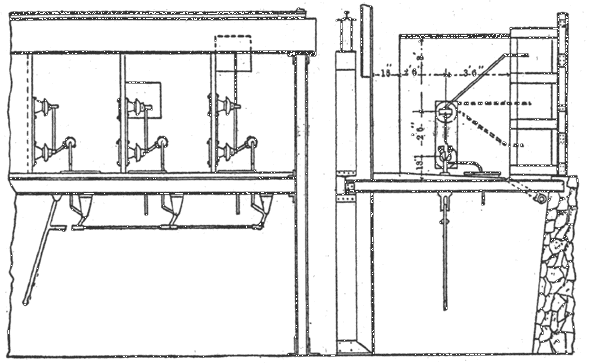 |
| Fig. 3. Elevations of High-Tension Oil Switches. Long-Distance High-Tension Transmission in California. |
Other than the line heretofore mentioned, conveying power from Colgate to the Bay of San Francisco, the line of the Standard Electric Company to the power plant at Electra, on the Mokelumne River, a distance of 142 miles from San Francisco, is an illustration of the possibilities of the increase of the efficiency of the line by high insulation. When first constructed this line was operated at 33,000 volts, which potential was maintained until March, 1904, when steps were taken to operate it in parallel with the other lines controlled by the California Gas and Electric Corporation, the Bay Counties and the Valley Counties companies, and it was at that time increased to 55,000, and has been so operated ever since. The type of insulators in use in March, 1904, has been substituted for the four-part type illustrated in such sections of the territory of the Standard as by reason of climatic conditions called for a higher insulation.
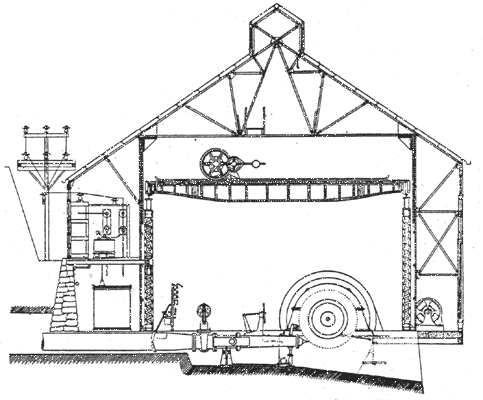 |
| Fig. 4. Arrangement of Power House and Switch Gallery. Long-Distance High-Tension Transmission in California. |
Outside of the immediate fog belt mentioned two and three-part types of insulators have been found extremely efficient for voltages up to 60,000, and experiments have been made to demonstrate that they will safely carry 80,000 volts without breaking down.
The progress made in the engineering and construction work of power houses has kept pace with the progress in pole-line work and insulating and switching devices. The chart herewith, Fig. 6, giving the area of power houses, graphically shows the contraction of areas in the installation of large units, as it follows closely in the. line of distributing stations, where, as can be remembered, the belted units for alternating-current work have increased from 35 kilowatts to the large direct-connected units now in vogue, in some cases as high as 12,000 kilowatts. The first installation made at Electra, in 1899, of five 2,000-kilowatt units, called for a floor space equal to 1.16 square feet per kilowatt; the Colgate installation made in 1897, of 9,400 kilowatts, called for 0.98 square feet per kilowatt; the recent installation at the de Sabia power, house of the Valley Counties Power Company of 9,000 kilowatts called for but 0.4 square feet per kilowatt. The installation now being made at Electra of two 5,000-kilowatt units calls for but 0.288 square feet per kilowatt. The areas given include room for transformers, switches and so forth.
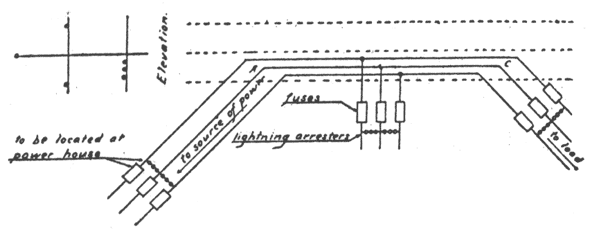 |
| Fig. 5. Method of Protecting Distributing Systems. |
It will be noted that the first installation at Electra required four times the floor space per kilowatt as compared with the work at present being done, and illustrates more clearly than words can convey the advancement in the last six years. It is believed that the floor area per kilowatt in the new Electra installation is less than that of any other power plant in existence today. In these plants there is no crowding of apparatus, and there is ample room for all operation or repairs, and in future work it will be safe to assume that this minimum of floor space can be still further reduced. Reduced floor area means, of course, reduced operating expenses as well as reduced cost of construction.
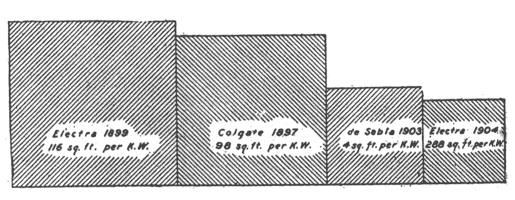 |
| Fig. 6. Chart Showing Comparative Power House Areas. |
When it is considered that the operation of these power plants extends to an infinity of uses, from the moving of street cars to the operation of sewing machines; from factories using ponderous machinery and exacting conditions of demand to the most minute uses to which electricity can be applied, and that during the four years of active operation on this coast new contracts are continually being made for the use of electricity against the installation of steam plants that might be operated with the cheapest fuel known (which is California oil at between 55 and 60 cents per barrel of 42 gallons), it is a tribute to the knowledge, perseverance and energy of the engineers that such work has been accomplished and so perfectly done in so short a space of time. Motors as large as 800 horsepower come on and off the line unnoticed.
† Abstract of a paper read before the Denver-Colorado Springs convention of the National Electric Light Association, June 7, 1905.
